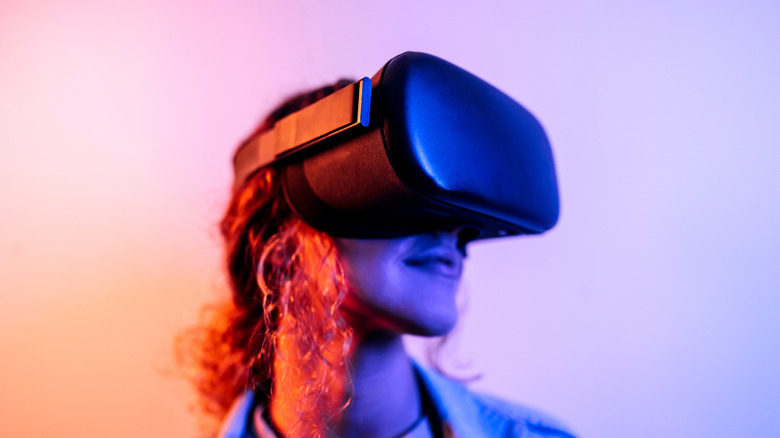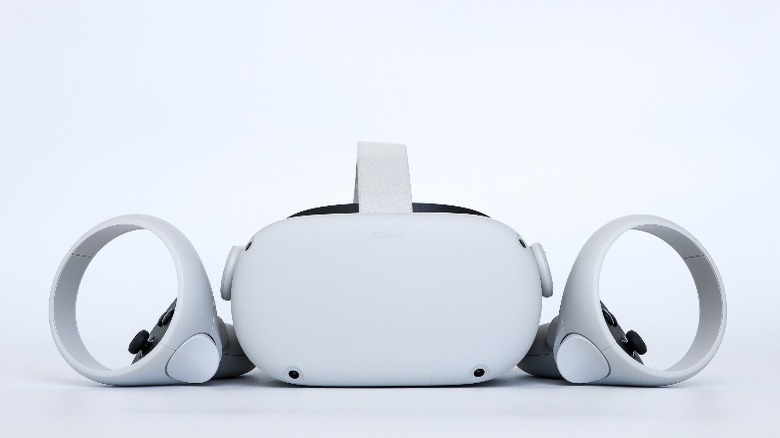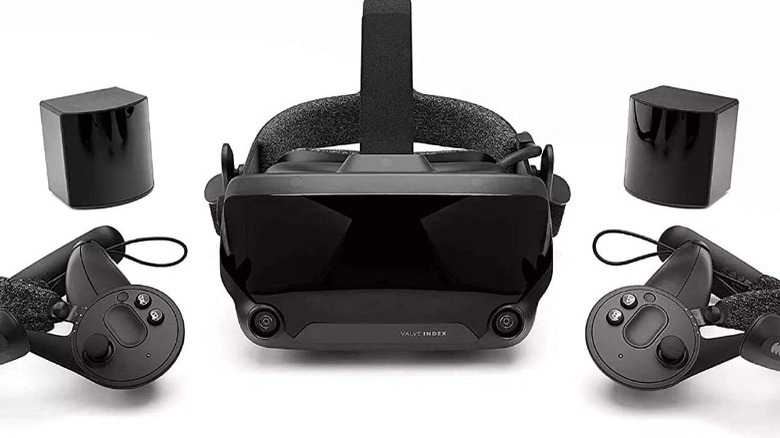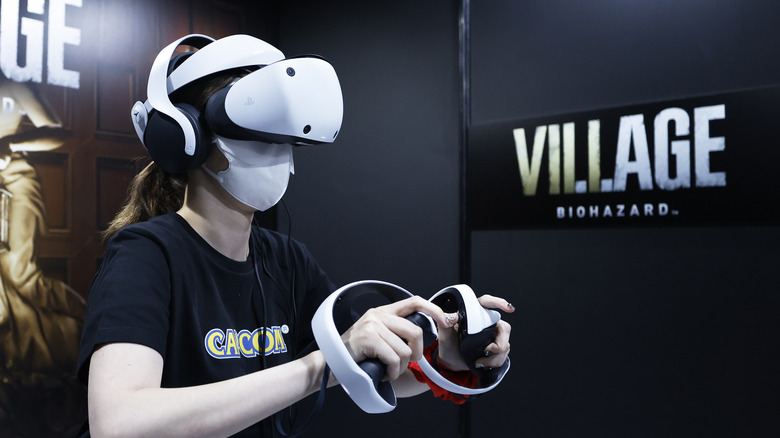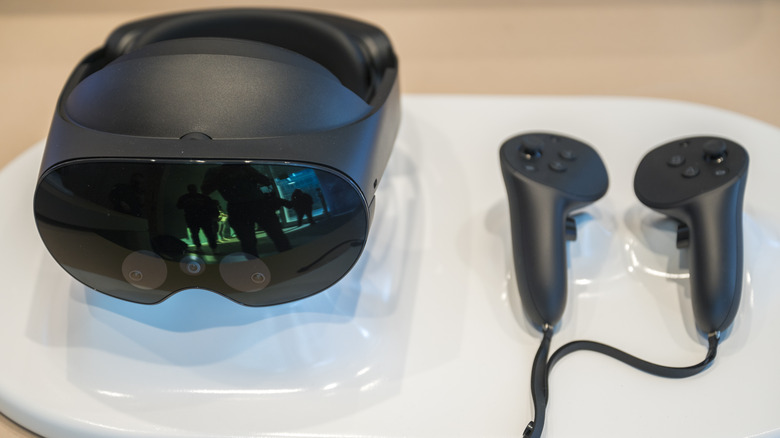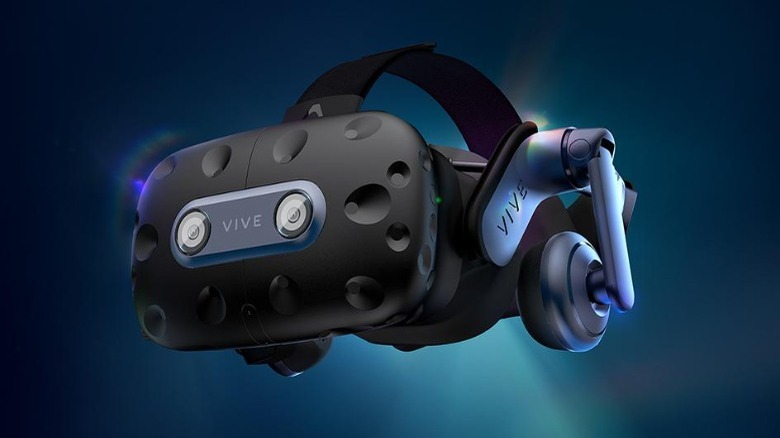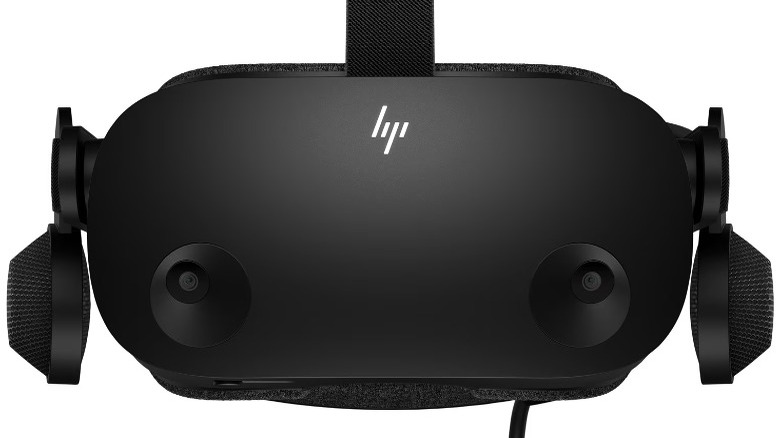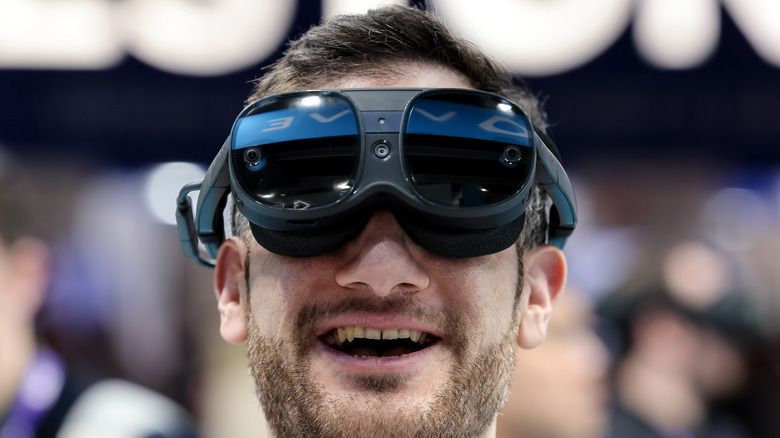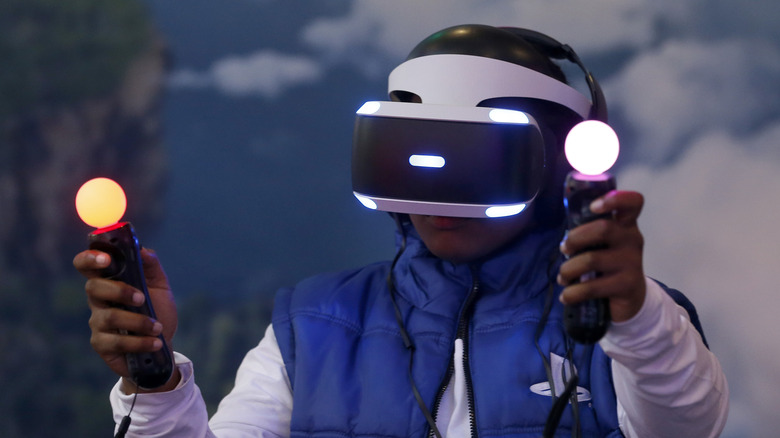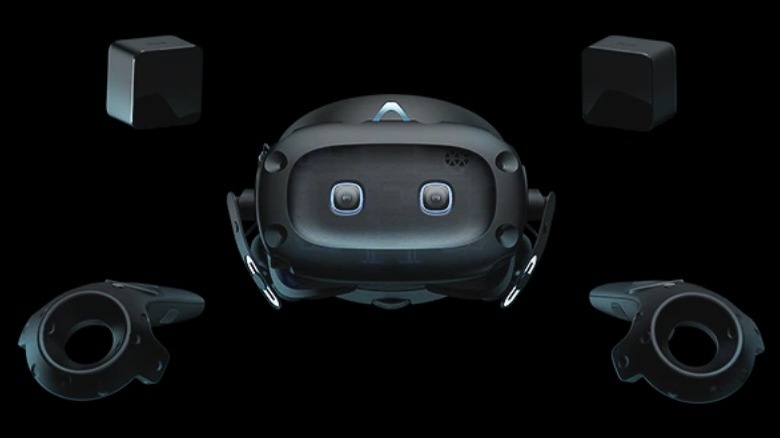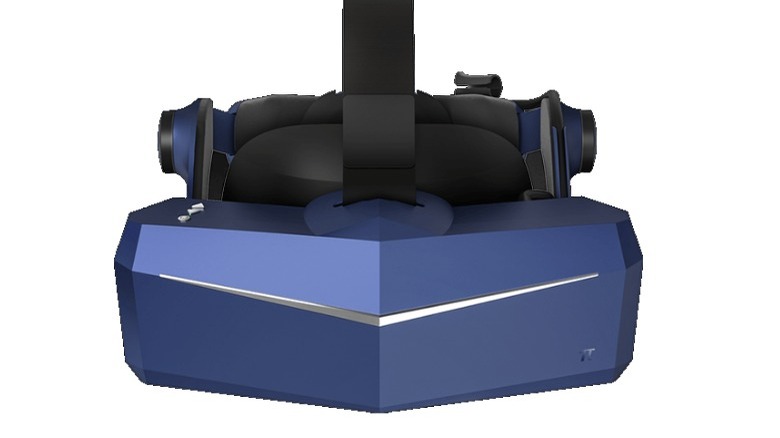VR Headsets Actually Worth Buying Right Now
It was not too long ago when virtual reality gaming was something of a niche that very few people actually experienced. But a combination of factors, including cheaper options and wider availability of products, means that there is a growing market for VR headsets that can play immersive games. Many major publishers and developers are even adding virtual reality support to blockbuster titles such as "Skyrim."
However, for anyone who wants to try out these experiences for themselves, choosing the right VR headset can be a daunting decision. After all, many of these devices cost as much as a high-end gaming PC and there are so many different headsets to choose from that it can be hard to know which is the best one for you. Fortunately, there are a few standout examples that are more than worth your money, combining affordability, quality, and comfort into one package.
Every one of these VR headsets is among the very best of the best when it comes to virtual reality and should be top of any list when deciding what device to go for.
Meta Quest 2
Developed by Meta's Reality Labs, the Meta Quest 2 is the second iteration of the virtual reality headset that was originally released in 2019 under the name Oculus Quest. An evolution of that design, it looks largely the same at first glance but does come with a variety of improvements that ensure it is one of the best options when it comes to VR. Chief among them is the higher resolution in the display that delivers a crisper image to users along with a higher refresh rate for smoother on-screen movement.
The Meta Quest 2 also features a more lightweight design that should make playing for longer periods more comfortable. Improved battery life for the headset and controllers also allows for longer game sessions while the extra processing power and memory within the device allows it to run more demanding games. This headset is also priced at a more competitive $429 for the 256GB model, a full $70 cheaper than the introductory price of the Oculus Quest which only came with 128GB of storage.
With its ability to run software as a standalone product and from desktop computers, the Meta Quest 2 can do a bit of everything reasonably well and is a great introduction to the world of virtual reality — especially for those who don't particularly want to spend huge sums of money to get the highest possible specs.
Valve Index
It shouldn't come as a surprise that Valve would enter the virtual reality headset market at some point. After all, the company has the most commonly used digital storefront on PC and a huge catalog of VR games. Valve had also earlier collaborated with HTC to produce the Vive, another virtual reality headset, giving the company some experience in developing virtual reality hardware. All of this led to the 2019 launch of the Valve Index, a high-end VR headset
As one of the more expensive options on the market, the Valve Index does plenty to make up for its high price. It has a high refresh rate of 120Hz but is also able to run at both 80Hz and 90Hz with support for an experimental 144Hz available, as well. Combined with its dual 1440×1600 LCD screens, off-ear headphones, and optimized pixel layout, it is an immersive and comfortable VR headset. There's also good news for those who previously owned HTC devices as the Valve Index is compatible with earlier controllers and base stations, meaning you might not have to spend extra money on purchasing new peripherals and accessories.
As an extra bonus for those who purchase this particular headset, Valve also throws in the highly-acclaimed virtual reality game "Half-Life: Alyx."
PlayStation VR2
Sony first launched a virtual reality kit back in 2016, with the PlayStation VR released for the PS4. While reception to the device was mostly positive, some did criticize it for its lack of quality blockbuster titles. However, this is simply because the headset was designed to be used exclusively with the PS4 and so didn't have the same capabilities as a powerful gaming PC. Sony followed this original product up in 2023, releasing the PS5-compatible PlayStation VR2.
The fact that the PS VR2 has been designed specifically for the PS5 gives it some distinct advantages. For example, it connects to the console via a simple USB-C cable, meaning there's no need for a complicated setup or lots of different wires. Of course, this means that it can only be used for games released through Sony's own online store. The device sports A twin OLED panel that supports 4K resolution and frame rates of 90Hz and 120Hz. The designers also worked hard to make it lighter and more comfortable to wear, a common complaint of VR headsets.
While the PS VR2 does have some drawbacks, including a wired connection that may get in the way during play sessions, it is undoubtedly one of the best VR headsets available right now. SlashGear found that it was a good value product that is easy to recommend to those who want to try out virtual reality without having to invest in an expensive PC.
Meta Quest Pro
Meta already has a number of virtual reality devices on the market. Most notable among them is the Meta Quest 2, which is an entry-level headset that can give gamers a decent experience at a very reasonable price. However, the company has also launched a higher-end device to try and appeal to those who want a more immersive and all-encompassing experience. Known as the Meta Quest Pro, it costs $1,499, making it more than three times as expensive as its cheaper predecessor.
For all that extra money, the Meta Quest Pro certainly packs a punch and has some unique features that help it stand out from Meta's other virtual reality products. Perhaps the most obvious of them is that the Meta Quest Pro utilizes augmented and mixed reality elements in a similar fashion to Microsoft's own HoloLens project. This blends virtual elements with the real world to provide an experience not available on most VR headsets, which includes the Passthrough feature that can present text and images on real-life objects.
Throw in the higher resolution quantum dot displays LCD displays and double the RAM to ensure this headset looks and performs better than the Meta Quest 2. Of particular note are the new compact controller design and the better weight distribution thanks to the battery being attached to the back of the headset.
HTC Vive Pro 2
Costing $1,400, the HTC Vive Pro 2 is among the most expensive commercial VR headsets currently on the market. However, that high price doesn't go to waste, with the device capable of delivering a native resolution of 4896 x 2448 and offering a field of view of 120 degrees. Throw in the 120HZ refresh rate and the HTC Vive Pro 2 is a headset that promises users some of the best visuals available. The one downside to this is that the device needs a pretty powerful computer to connect to.
The HTC Vive Pro 2 even supports HTC's wireless adapter, meaning that it can be played without any physical connection to a PC. However, that will limit gamers to a lower refresh rate of just 90Hz rather than the higher 120Hz. Those who have already owned a previous HTC VR headset will also be able to simply buy the headset as previous controllers and base stations are compatible with the newer model. For audiophiles, the headset features Hi-Res Audi Certified headphones that come with 3D spatial sound.
HP Reverb G2
While the VR headset market has largely been dominated by just a few manufacturers — including Meta, HTC, Valve, and Sony — there are some other options out there for people who want to give virtual reality gaming a chance. The HP Reverb G2 is one such example, a mixed reality headset that had a sharp resolution of 4K across both lenses and an impressive 114-degree field of view. The image quality is so good that it almost completely avoids the screen door effect which has been a huge problem for VR headsets since they first launched.
Utilizing Microsoft's spatial audio technology as well as an audio format developed by HP Labs that features artificial intelligence, it offers great sound to users. Meanwhile, the newly designed speakers have a small gap between the ear for comfort and to ensure the spatial 3D audio works exactly as intended. Additionally, the headset features four cameras to track the controllers and user movements so there's no need for any external sensors that need to be set up, giving players more freedom when it comes to choosing where to use the headset.
This means that the HP Reverb G2 is among the easier VR headsets to plug in and play as it is far more user-friendly than some of its competitors. A 20-foot cable to connect it to the PC also provides lots of freedom to move around.
HTC Vive XR Elite
HTC has been a major player in the virtual reality market for some time now and its latest offering is a high-end product that is designed to compete against the likes of the Meta Quest Pro. The HTC Vive XR Elite can be used as a standalone wireless headset thanks to its battery, which can provide up to two hours of gaming on a single charge, or connected directly to a PC. Like the Meta Quest Pro, it features 12GB of RAM while the 128GB of internal storage should be plenty considering the size of most virtual reality apps and games available for the system.
For those who want their gadgets to look stylish, the HTC Vive XR Elite is arguably the best-looking VR headset thanks to its stylish design and small form factor. This has the added benefit of making the headset lightweight compared to many other alternatives and it can be worn for long periods without causing too much discomfort. The location of the battery at the back of the device also means the weight is distributed evenly, which should help with comfort, as well.
One particular praiseworthy feature is its support for Wi-Fi 6E, which provides seamless wireless performance that is essentially on par with a wired connection. SlashGear noted in its review that the HTC Vive XR Elite's "lightness, comfort, connectivity, and display make it a superb choice" for anyone who wants a high-end virtual reality setup.
PlayStation VR
Although it is now almost seven years old, the PlayStation VR still has a lot to offer to anyone looking to try out virtual reality gaming on a budget. This particular headset has a number of advantages over many of its rivals, including the fact that it is now much more affordable than other similar products and works with the PS4 and PS5. What that means for gamers is that they don't have to go out and purchase a high-end PC to play virtual reality games and can instead stick with a console that they might already have.
That makes PlayStation VR an enticing prospect, especially for console gamers. Even its specs are not bad given its age and price, with a 5.7-inch OLED panel that has a resolution of 1080p and 3D audio. It is also fairly easy to set up and play, using the PlayStation Camera to accurately track your movement through LEDs located across the headset.
Sony provides a great catalog of titles, with a library that boasts more than 500 games of various sizes for download. That means there should be something for anybody using the PlayStation VR, like "Marvel's Iron Man VR" and "Hitman 3" as well as first-party releases such as "Astro Bot Rescue Mission." As an entry-level headset, there are few better options that will provide the same level of comfort and quality at such a low price.
HTC Vive Cosmos Elite
Another high-performing HTC headset is the HTC Vive Cosmos Elite. It is higher on the budget end of the spectrum when it comes to virtual reality devices and comes equipped with a 4.3-inch LCD screen that is capable of outputting resolutions of 1440 x 1700 at a refresh rate of 90Hz. Using several base stations to accurately track user movements rather than relying solely on cameras mounted on the headset, it requires a relatively large playing area and several power outlets. But that shouldn't put off anyone looking for a dedicated virtual reality setup that won't break the bank.
Originally launched as part of a bundle that included multiple base stations and controllers, the headset now has a standalone release. This has made it a far more tempting option for those who already own other HTC devices and are considering upgrading, as it is compatible with all past accessories. The HTC Vive Cosmos Elite is available at $549 as a standalone purchase or $900 as part of the original bundle. As an added bonus, buyers also get a free copy of "Half-Life Alyx" to go with the headset and really show what virtual reality is capable of in games.
Pimax 5K Vision Super
The Primax 5K Vision Super is a VR headset from the Chinese virtual reality specialist Pimax. As you might expect from the name, it has a combined resolution of 5K and a wide range of FOV and refresh rate options. At its highest setting, the device offers a field of view of 170 degrees horizontally and 115 vertically. However, this number will drop depending on the chosen refresh rate, which can go up as high as 180Hz. Sacrificing one of these to enable the highest settings of the other may sound silly but it means users have a whole host of options to tailor the experience to their own standards.
In terms of sound, this headset uses a rather unique solution that sees audio being output from speakers at the top of the device. For those who want a more immersive experience, in-ear headphones can also be purchased at an additional cost. Reviews have also noted the quality of the microphone, allowing for clearer communication. Combined with an easy-to-use interface and a more user-friendly initial startup process, the Primax 5K Vision Super is one of the best quality starter virtual reality devices available.
